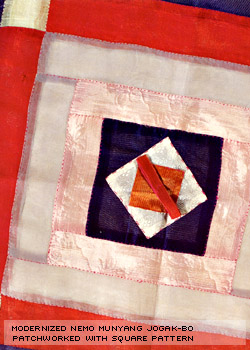
Bojagi (Wrapping Cloths) is perhaps the most unique form of Korean
textile art. It is also strikingly contemporary: the designs
and colors of bojagi remind one of the works of some modern
abstract artists. Indeed, the bojagi can be described as
a true form of abstract expressionism. Bojagi are Korean
textiles which pieced together from small scraps of cloth.
Bojagi occupied a prominent place in the daily lives of Koreans of all classes. They were used to wrap or carry everything from precious ritual objects to everyday clothes and common household goods and also to cover foodstuffs from ritual offerings to dining tables and trays.
Many different bojagi can be categorized by the class of users, make-up, design, material and size.
Gungbo is the bojagi used in the royal palace to wrap various kinds of goods. It was produced by the artisan organizations that were specializes in each step in the whole process-weaving, dyeing, drawing, sewing and etc.
Minbo is the bojagi used by common people. There were many kinds of minbo as diverse as the items wrapped in. People used bojagi for daily use purposes, weddings, special events and rituals.
Bojagi are usually square and come in a range of sizes. Fabrics used in bojagi include silk, cotton, hemp and ramie. There are many different types of bojagi including lined or unlined, embroidered, painted, gold-leafed, quilted.
see also
Patchworked bojagi (jogakbo)
Embroidered bojagi (subo)
Source: Hur, Dong-hwa, Bojagi’s Simple Elegance (Seoul; The museum of Korean Embroidery, 2004)
Bojagi occupied a prominent place in the daily lives of Koreans of all classes. They were used to wrap or carry everything from precious ritual objects to everyday clothes and common household goods and also to cover foodstuffs from ritual offerings to dining tables and trays.
Many different bojagi can be categorized by the class of users, make-up, design, material and size.
Gungbo is the bojagi used in the royal palace to wrap various kinds of goods. It was produced by the artisan organizations that were specializes in each step in the whole process-weaving, dyeing, drawing, sewing and etc.
Minbo is the bojagi used by common people. There were many kinds of minbo as diverse as the items wrapped in. People used bojagi for daily use purposes, weddings, special events and rituals.
Bojagi are usually square and come in a range of sizes. Fabrics used in bojagi include silk, cotton, hemp and ramie. There are many different types of bojagi including lined or unlined, embroidered, painted, gold-leafed, quilted.
see also
Patchworked bojagi (jogakbo)
Embroidered bojagi (subo)
Source: Hur, Dong-hwa, Bojagi’s Simple Elegance (Seoul; The museum of Korean Embroidery, 2004)

